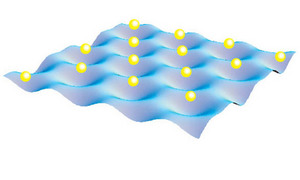Dec. 15, 2006 Research Highlight Physics / Astronomy
Surfing electrons make a splash
Electron arrays floating on superfluid helium provide access to the fundamental properties of the liquid below
 Figure 1: Schematic of the regular array of electrons (yellow)—the Wigner solid—that floats on top the superfluid3He (blue), leading to periodic deformations.
Figure 1: Schematic of the regular array of electrons (yellow)—the Wigner solid—that floats on top the superfluid3He (blue), leading to periodic deformations.
One of the most well-known fundamental physical effects is superconductivity: the flow of electrons without electrical resistance in certain materials that occurs when the electrons form pairs at very low temperatures.
A related effect occurs in the rare helium isotope helium-3 (3He) at extremely low temperatures of only a thousandth of a degree above absolute zero, where 3He is a liquid. In a similar fashion to electrons in superconductors, the 3He atoms form pairs and create a new physical state—superfluidity. One of the characteristics of superfluids is the free flow of the liquid without any viscosity or resistance. Superfluid liquids can creep up on surfaces and leak through the tiniest of cracks.
The superfluid state of 3He is complex and shows a variety of different effects. In particular, the texture of 3He pairs at the surface of the liquid reveals fundamental properties that are difficult to obtain experimentally.
Using an ingenious method, Hiroki Ikegami and Kimitoshi Kono, who are physicists at RIKEN’s Discovery Research Institute at Wako, now report on the first complete mapping of the 3He superfluid properties1. Their method is based on electrons that are deposited and trapped on the surface of the 3He superfluid. Owing to the low temperature, the electrons arrange themselves in a regular two-dimensional array, known as Wigner solid (Fig. 1). The properties of the liquid strongly influence the electrical resistance of the electrons. When remaining unpaired 3He particles travel towards the surface, they hit periodic deformations and thus slow down the flow of electrons. Therefore, measurements yielded from mapping this electrical resistance can be used to determine the texture of the superfluid.
In fact, Ikegami and Kono are now able to map electrical resistance at an unprecedented range of temperatures and magnetic fields—external parameters that affect superfluids. Magnetic field data is particularly valuable, because the field modifies the pairing state of 3He atoms. “Previously, similar low-temperature measurements have been performed, but without a magnetic field,” says Ikegami. Determining the superfluid texture under different experimental conditions is a key achievement as it allows the verification of theoretical models.
“The aim is now to go to even lower temperatures of below a tenth thousandth of a degree above zero, where further delicate scattering effects at the surface are expected to occur,” says Ikegami. If successful, those experiments will advance our fundamental understanding of superfluidity and provide invaluable information on related effects such as high-temperature superconductivity.
References
- 1. Ikegami, H. & Kono, K. Texture of superfluid3He probed by a Wigner solid. Physical Review Letters 97, 165303 (2006). doi: 10.1103/PhysRevLett.97.165303
